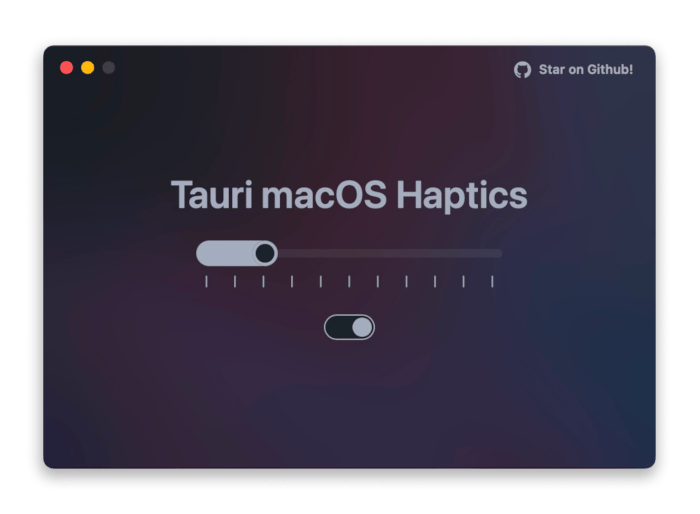3 releases (1 stable)
| 1.0.0 | Oct 3, 2024 |
|---|---|
| 1.0.0-rc.1 | Sep 11, 2024 |
| 1.0.0-rc.0 | Aug 24, 2024 |
#947 in GUI
205 downloads per month
12KB
132 lines
Tauri Plugin macOS Haptics
Utilize the Taptic Engine™️ on macOS for Tauri v2 apps.

Get the plugin
Using the command line from crates.io:
$ cargo add tauri-plugin-macos-haptics
Or add it manually to Cargo.toml:
[target.'cfg(target_os = "macos")'.dependencies]
tauri-plugin-macos-haptics = "1.0.0"
Note: if you want to include this only on macOS, put
Or get the latest using git:
[target.'cfg(target_os = "macos")'.dependencies]
tauri-plugin-macos-haptics = { git = "https://github.com/ItsEeleeya/tauri-plugin-macos-haptics/" }
Get the frontend bindings
pnpm add tauri-plugin-macos-haptics-api
# or
bun add tauri-plugin-macos-haptics-api
# or
npm add tauri-plugin-macos-haptics-api
# or
yarn add tauri-plugin-macos-haptics-api
Usage
1. First initialize the plugin
This is only needed if you want to use it from the frontend.
fn main() {
let mut builder = tauri::Builder::default();
#[cfg(target_os = "macos")]
{
// You can safely init the plugin on any platform.
// Or choose to only initialize it on macos.
builder = builder.plugin(tauri_plugin_macos_haptics::init());
}
builder
.run(tauri::generate_context!())
.expect("error while running tauri application");
}
2. Permissions
Add "macos-haptics:default" to your permissions.
Usually found under src-tauri/capabilities/*.json
Read more about the specific permissions.
3. Perform a haptic feedback
From Rust:
use tauri_plugin_macos_haptics::haptics::*;
fn provide_feedback() {
#[cfg(target_os = "macos")]
{
use tauri_plugin_macos_haptics::haptics::*;
NSHapticFeedbackManager::default_performer().perform(NSHapticFeedbackPattern::Generic, None).ok();
}
}
From the frontend (Typescript):
import {
isSupported,
perform,
HapticFeedbackPattern,
PerformanceTime,
} from "tauri-plugin-macos-haptics-api";
if (await isSupported()) {
perform(HapticFeedbackPattern.LevelChange, PerformanceTime.Now);
// Or call the function with no arguments to default to Generic and now.
}
⚠️ Please note that you should trigger a feedback ONLY in response to user-initiated actions. Ideally, visual feedback, such as a highlight or appearance of an alignment guide, should accompany the feedback.
In some cases, the system may override a call to this method. For example, a Force Touch trackpad won’t provide haptic feedback if the user isn’t touching the trackpad.
Haptic feedback is intended to be provided in response to a user action, such as aligning one object to another. Do not use it to provide feedback for events that are not user initiated. Excessive or unnecessary haptic feedback could be interpreted by the user as a malfunction and could encourage the user to disable haptic feedback entirely.
Learn more about NSHapticFeedbackManager (Apple's documentation)
Contributions
Any contributions are welcomed!
Dependencies
~17–54MB
~858K SLoC